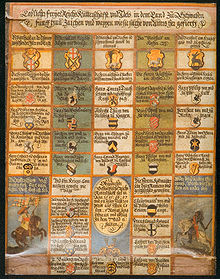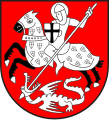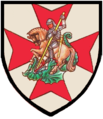Talk:Swabian League
| This article is rated Start-class on Wikipedia's content assessment scale. It is of interest to the following WikiProjects: | ||||||||||||||||||||||||||||||||||||||||||||||||||||||||||||||||||||||||||||||
| ||||||||||||||||||||||||||||||||||||||||||||||||||||||||||||||||||||||||||||||
Any one want to save this article?[edit]
This article ia a big mess-up and throws together two confederations that are not related and whose intentions and common enemies were diametrically opposed.
That is for one the Swabian City League of the 14th century. A coalition of imperial cities against the emerging territorial powers.
And that is the Swabian League of the turn of the 15th/16th century. A peacekeeping coalition of territiorial states, free knights and barons, imperial cities and church territories.
The article as it is now can only be saved by a big vacuum cleaner. --Wuselig 00:40, 14 November 2007 (UTC)
- How about two articles. Swabian City League of 1331 and Swabian League of 1488 with a disambiguation page? Or keep it as one article with two subsections. In the intro it would then have to be stressed that the two were formed independently.imars 08:06, 16 November 2007 (UTC)
- Two articles are a must. The one doesn't have anything to do with the other, nevertheless they are often confused, even in Germany. The one beeing a cooperation of the emerging cities to defend their interests against the emerging territorial powers in the political context of the early 14th Centuary. The other beeing a cooperation of all (or most to be precise) political entities in Southern Germany (Swabia) as a peacekeeping treaty organization. Now in the context of Pre-Reformation Germany. In this context the latter is interesting for the Project Lutheranism, wheras the former is interesting for the Projekt Middle Ages.--Wuselig 10:41, 16 November 2007 (UTC)
- I'll probably take a stab at some of this over the next few weeks, though do feel free to work on it in the interim. The two links you've given to the German Wikipedia articles will probably help a lot :o) — OwenBlacker (Talk)
This article is going from bad to worse. I am taking it of my watchlist. --Wuselig (talk) 20:44, 12 June 2013 (UTC)
Knight Templars, not St. George.[edit]
Hi Wuselig, with reference your edit (It's St George. The Templars have nothing to here. Or do you have literature to proof your point.) According to ISBN:1859580491: Concise Encyclopedia of Heraldry: GC Rothery: Ref pg 19. The Cross and its Variations: Quote: "The cross pateé, the distinguishing badge of the Knight Templars, is a cross whose four limbs expand at the extremities, and whose outer edges are flat." Accordingly, depicted as "pateé", this is a cross of the Knight Templars. Stephen2nd (talk) 23:21, 19 April 2010 (UTC)
- The Knights Templars active till 1314 did not have anything to do do with the Swabian League of 1499. The nobles who joined the Swabian League were all part of the organization of "League of St. George's Shield". In fact it was not the individual knights who joined the league, but the corporation of "League of St. George's Shield" joined the Swabian League. So your edit changing "In 1488 a new Swabian league was formed, at Esslingen, not only of 22 imperial cities but also of the Swabian knights' League of St. George's Shield, bishops, and princes...." to "In 1488 a new Swabian league was formed, at Esslingen, not only of 22 imperial cities but also of the Swabian Knights Templar League of bishops, and princes..." is absolutly wrong and only based on your anachronistic incorrect interpretation of heraldry.
- You may want to take a closer look at the articles Sankt Jörgenschild and actually better here in the German language wikipedia.--Wuselig (talk) 06:45, 20 April 2010 (UTC)
![]() The arms of the Swabian League; Blazon: Argent, a cross patée Gules.
The arms of the Swabian League; Blazon: Argent, a cross patée Gules.
![]() . The arms of the Knights Templars; Blazon: Argent, a cross patée Gules.
. The arms of the Knights Templars; Blazon: Argent, a cross patée Gules.
![]() The arms of Saint George; Blazon: Argent a cross Gules.
The arms of Saint George; Blazon: Argent a cross Gules.
I cannot find any references whatsoever about any knighthood called a ‘League of St. Georges Shield’. However, you may want to look at House of Hohenstaufen (Swabian dynasty) During the political decentralization of the Hohenstaufen period, the towns often subordinate to local rulers or the emperor. Colonization of the east also continued in the thirteenth century, most notably through the efforts of the Knights of the Teutonic Order. (Ref: European Civic Arms) "Some towns on the territory of the former Teutonic knights, still bear the same Cross patée [as “Swabia”] e.g. Konigsberg, now Kaliningrad, and Elbing, now Elblag in Poland". This may suggest that lands of “Swabia” (Hohenstaufen) were formerly, or at one time, the territories of the Teutonic Knights. Stephen2nd (talk) 16:28, 20 April 2010 (UTC)
- "This may suggest...": If you want to rewrite the history of Southwestern German History you can do so everywhere but in Wikipedia. Again you point out anachronistic comparissons. Between the decline of the Hohenstaufen and the Swabian League of 1499 lie more than 200 years. I have pointed out the grave mistake of this article, that it confuses the “Swabian City Leagues” and the “Swabian League of 1499” already above. The Teutonic Knights did have territories in Swabia, but the so called Free imperial citys did not - I repeat: did not subjugate themselves to the Teutonic Knights. The Teutonic knights, if at all joined the league in their office as Prelates of their territories. The church territories were one minor block, the cities were another block with larger influence, the princes were a third block and the lesser nobles with independant territories, only subject to the emperor joined in the block of the 'Knightly-society of saint George's Shield' (you can find them listed here). If you want to keep on suggesting - with not the least competence in the history of late medieval Southwestern Germany - feel free to go ahead. I did not have the time to sort this poor article out, but I have kept it on my watch-list to keep out the grossest mistakes. If your revision of history with your invention of a “Swabian Knights Templar League of bishops” prevails, I will take this page off my watch-list, as not to watch its further decline. --Wuselig (talk) 21:55, 20 April 2010 (UTC)
- With regards your grossest mistake, (with not the least competence in heraldry, or arms, Re: your anachronistic comparison, between a “red cross patee of Knight Templars”, and a “red cross of St. George”): It is you who are rewriting German history. Irrelevant of spurious references to a 'Knightly-society of saint George's Shield;' The banner and shields (in your Wiki image) are not the arms (or shield) of St. George, nor, the arms of Swabia.
- This image that you uploaded is an artistic impression of a Teutonic knight in Armour, holding a lance and a shield, displaying a “banner” (not flag) of a cross patee of the order. The same arms in the bottom section are quoted & cited, as those of the Templar Knights. The lion in your image, also seen in the arms of the Grand Master of the Teutonic Order, is Quote: “the drawing of the lion in the Swabian coat of arms.” – Which is quoted from: The “Encyclopedia of Armory,” Ref: Art Historical Collection of the Austrian Imperial Family (Schloss Ambrras, near Innsbruck) Ref: the Swabia arms: Or, three lions passant in pale sable. Swabia (p434/plCVIII) is listed on the same image as the Grand Master of the Teutonic Order (p434/fig1045), who received “cross potent (Jerusalem Cross)” from King John of Jerusalem in 1219. Also, according to Wikipedia see (Main article: Coat of arms of Bavaria) “Or, three lions passant guardant sable, armed and langued gules – Quote - “This represents Swabia.” See also: [File:Wappen Schwaben Bayern.svg].
- With reference Wikipedia’s opinion - “This article may require cleanup to meet Wikipedia's quality standards - if you wish to improve this article” - or, if you wish to take this poor, badly sourced, and misleading article from your watch list - feel free to go ahead. Stephen2nd (talk) 15:30, 21 April 2010 (UTC)
- I don't care about your interpetration of this image, but if you take your interpretation of this image to make the following statement: "In 1488 a new Swabian league was formed, at Esslingen, not only of 22 imperial cities but also of the Swabian Knights Templar League of bishops, and princes..." than I object, because that is Original Research. The role of the "irrelevant of spurious referenced 'Knightly-society of saint George's Shield'" is well documented and you can read in any of the follwing publications:
- Ernst Bock: Der Schwäbische Bund und seine Verfassungen (1488–1534). Ein Beitrag zur Geschichte der Zeit der Reichsreform. Marcus, Breslau 1927
- Helmo Hesslinger: Die Anfänge des Schwäbischen Bundes. Ein Beitrag zur Geschichte des Einungswesens und der Reichsreform unter Kaiser Friedrich III. (= Forschungen zur Geschichte der Stadt Ulm; Bd. 9). Stadtarchiv, Ulm 1970 (zugl. Dissertation, Universität Tübingen)
- Eduard Osann: Zur Geschichte des schwäbischen Bundes. Von seiner Gründung 1487, bis zum Tode Kaiser Friedrich's III., 1493. Gießen 1861 (Digitalisat)
- Volker Press: Das Alte Reich. Ausgewählte Aufsätze. 2. Auflage. Duncker & Humblot, Berlin 2000, ISBN 3-428-09138-8
- but it will be enough if you stick to the standard publication by:
- Horst Carl: Der Schwäbische Bund 1488–1534. Landfrieden und Genossenschaft im Übergang vom Spätmittelalter zur Reformation. (= Schriften zur südwestdeutschen Landeskunde; 24). DRW, Leinfelden-Echterdingen 2000, ISBN 3-87181-424-5 bzw. ISBN 3-7995-5224-3
- But for me, this is eod here, I can waste my time more efficiently elsewere. --Wuselig (talk) 21:25, 21 April 2010 (UTC)
- I have no interest whatsoever in your interpretation of German history. If your 'Knightly-society of saint George's Shield' is quoted in these books, then it is acceptable for Wikipedia. However, I will change your incorrect interpretation and description of the image, as my quotes are (Ref: Wikipedia) encyclopedic information verified by external sources, which prove these arms to be those of the Knight Templars, not St. George. Stephen2nd (talk) 22:26, 21 April 2010 (UTC)
- I don't care about your interpetration of this image, but if you take your interpretation of this image to make the following statement: "In 1488 a new Swabian league was formed, at Esslingen, not only of 22 imperial cities but also of the Swabian Knights Templar League of bishops, and princes..." than I object, because that is Original Research. The role of the "irrelevant of spurious referenced 'Knightly-society of saint George's Shield'" is well documented and you can read in any of the follwing publications:
Suggested refs: Swabian knights' League of St. George's Shield, bishops, and princes?? = Archbishopric of Trier = Electorate of Trier = Kingdom of Arles = Imperial vicar = Albert II of Germany = Knights of the Garter = St. George's Shield?? Stephen2nd (talk) 23:39, 23 April 2010 (UTC)
- St. George was depicted with any form of a cross in art and in heraldry, so you can find exemples either way. But the images in themselves are no proof for whatever.

- But, if you are such an expert in heraldry you might want to give us an interpertration of this plate:
--Wuselig (talk) 08:15, 24 April 2010 (UTC)
File:Stadtwappennoerdlingen.jpg Nominated for Deletion[edit]

|
An image used in this article, File:Stadtwappennoerdlingen.jpg, has been nominated for deletion at Wikimedia Commons in the following category: Deletion requests April 2012
Don't panic; a discussion will now take place over on Commons about whether to remove the file. This gives you an opportunity to contest the deletion, although please review Commons guidelines before doing so.
To take part in any discussion, or to review a more detailed deletion rationale please visit the relevant image page (File:Stadtwappennoerdlingen.jpg) This is Bot placed notification, another user has nominated/tagged the image --CommonsNotificationBot (talk) 10:26, 5 April 2012 (UTC) |
- Start-Class Germany articles
- Mid-importance Germany articles
- WikiProject Germany articles
- Start-Class former country articles
- Start-Class Holy Roman Empire articles
- Unknown-importance Holy Roman Empire articles
- Holy Roman Empire task force articles
- WikiProject Former countries articles
- Start-Class Lutheranism articles
- Low-importance Lutheranism articles
- Start-Class Christianity articles
- WikiProject Lutheranism articles
- Start-Class Middle Ages articles
- Low-importance Middle Ages articles
- Start-Class history articles
- All WikiProject Middle Ages pages
- Start-Class military history articles
- Start-Class European military history articles
- European military history task force articles
- Start-Class German military history articles
- German military history task force articles
- Start-Class Medieval warfare articles
- Medieval warfare task force articles
- Start-Class Early Modern warfare articles
- Early Modern warfare task force articles
















